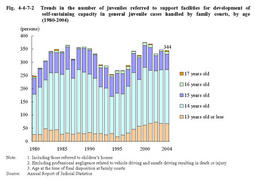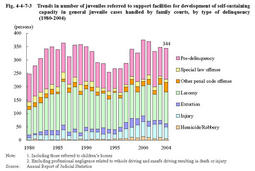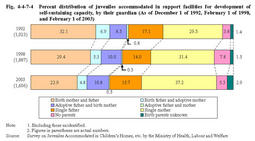| Previous Next Index Image Index Year Selection | |
|
|
3 Characteristics of accommodated juveniles (1) Age As of February1,2003,32.1%of accommodated juveniles were14years old when they were admitted to support facilities for development of self-sustaining capacity,28.9%were13years old,12.5%were12years old,and11.0%were15years old.10.3%of those accommodated juveniles were supposed to be at elementary schools,76.4%were supposed to be at junior high schools,10.3%were supposed to have graduated from junior high schools(and not have attended senior high schools),and3.0%attended to senior high schools(Source:Survey on Juveniles Accommodated in Children's Homes,etc.by the Ministry of Health,Labour and Welfare).
Fig.4-4-7-2 shows the number of juveniles referred to support facilities for development of self-sustaining capacity or children's homes(those referred to children's homes were extremely small in number)as protective measures in general juvenile cases handled by family courts(excluding professional negligence related to vehicle driving and unsafe driving resulting in death or injury;hereinafter the same in this Section),by age since1980. The total number of those referred was344in2004.By age,the number of referred juveniles aged13or younger was67in2004. Fig.4-4-7-2 Trends in the number of juveniles referred to support facilities for development of self-sustaining capacity in general juvenile cases handled by family courts,by age(1980-2004) (2) Type of delinquency committed by juveniles referred to by family courts Fig.4-4-7-3 shows the number of juveniles referred to support facilities for development of self-sustaining capacity or children's homes as protective measures in general juvenile cases handled by family courts,by type of delinquency since1980.
Larceny and pre-delinquency were most common every year,accounting for34.3%and33.7%,respectively,in2004. Fig.4-4-7-3 Trends in number of juveniles referred to support facilities for development of self-sustaining capacity in general juvenile cases handled by family courts,by type of delinquency(1980-2004) (3) Situation off a milies Fig.4-4-7-4 shows the percent distribution of juveniles accommodated in support facilities for development of self-sustaining capacity,by their guardian(comparison between December1of1992,February1of1998,and February1of2003).
Fig.4-4-7-4 Percent distribution of juveniles accommodated in support facilities for development of self-sustaining capacity,by their guardian(As of December1of1992,February1of1998,and February1of2003) The percentage of juveniles who have birth parents has been on a declining trend,and was less than a quarter(22.9%)in2003.The percentage of juveniles'parents with problems such as"neglect/negligence","abuse/maltreatment",and"abandonment of child/refusal of child-rearing"has been on a rise and was37.5%in total as of February1,2003(Source:Survey on Juveniles Accommodated in Children's Homes,etc.by the Ministry of Health,Labour and Welfare). |


